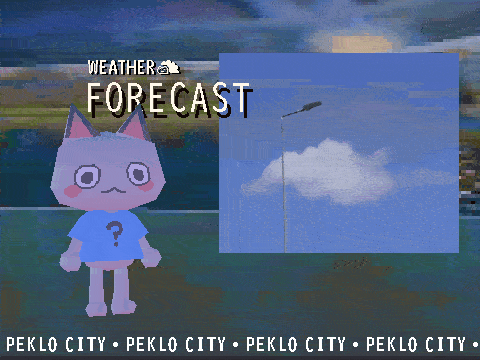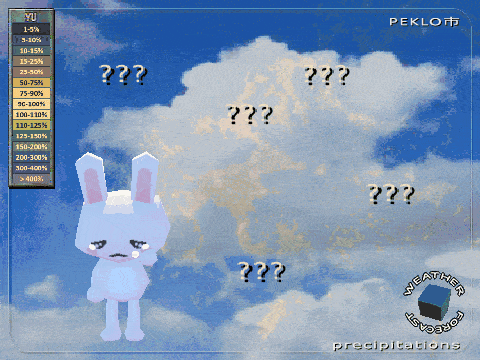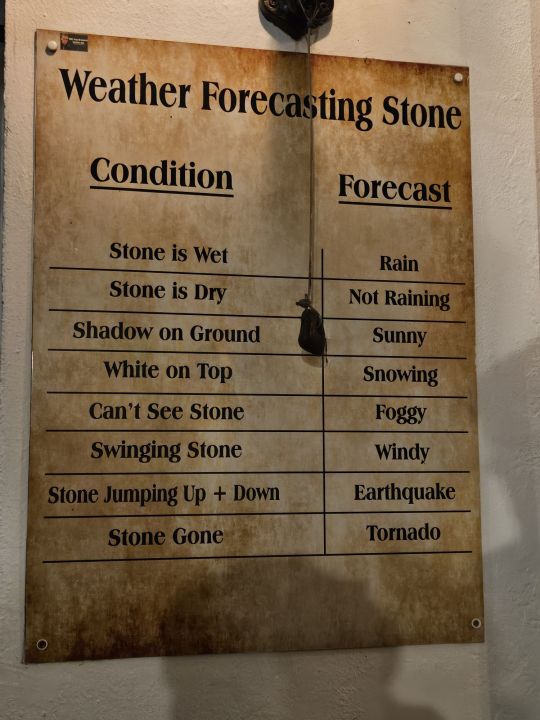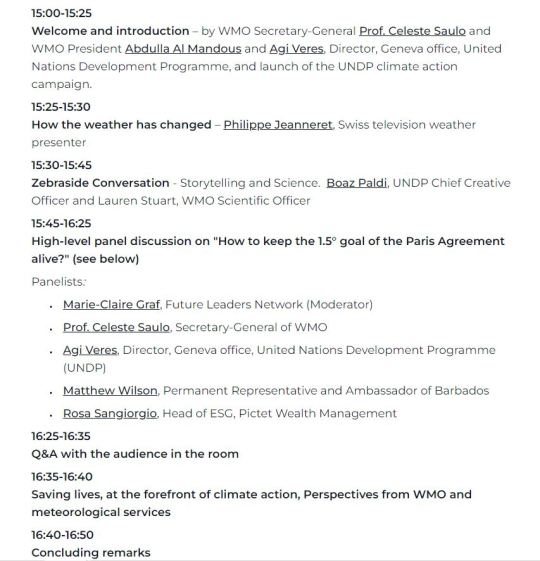#Weather forecasting
Text






I FUCKING LOVE LEARNING ABOUT THE LOGISTICS OF WEATHER FORECASTING!!!!!!
#personal stuff#dougie rambles#weather#weather forecast#weather forecasting#noaa#meteorology#weather station#weather balloon#satellites#gushing#forecasting#data#data analysis
25 notes
·
View notes
Text
Weather forecasting
A musty, productive, refreshing rainy day.
--- Japan's rainy season
カビくさい、生産的で、爽やかな雨の日。
――日本の梅雨
Rei Morishita
4 notes
·
View notes
Text



your local forecast
30K notes
·
View notes
Text
Irish weather forecasting
Life in a country facing all the Atlantic Ocean is able to throw at you means the weather is a continual topic of interest.
On a recent visit to Dublin, The Brazen Head pub, the oldest in all of Ireland, offered invaluable advice built on 8 centuries of experience…
Until we speak again, remember in Dublin all four seasons often happen… in the same day!

View On WordPress
#cats#cats humour#Dublin#Dublin weather#Eire#Ireland#Irish weather#Republic of Ireland#The Brazen Head#weather#weather forecasting
0 notes
Text
Exploring How Weather Influences Tourism Trends and Travel Behavior

Weather has always been a dominant force shaping human behavior, and this influence extends profoundly into the realm of tourism. Whether it's the allure of pristine beaches under a scorching sun or the magical charm of winter wonderlands blanketed in snow, travelers are inherently drawn to destinations that offer the climate they desire. In this article, we delve into the intricate relationship between weather patterns and tourism trends, exploring how fluctuations in temperature, precipitation, and seasonal changes impact travel behavior worldwide.
Seasonal Variations:
One of the most apparent manifestations of weather's influence on tourism is the seasonal ebb and flow of travelers. Each season brings its own set of climatic conditions, which in turn dictate the type of experiences and activities available to tourists. For instance, the summer months often see a surge in beach vacations, as people seek relief from the heat by indulging in coastal retreats. Conversely, winter beckons adventure enthusiasts to snowy slopes and cozy chalets, fostering a bustling ski tourism industry.

Regional Preferences:
Beyond seasonal variations, regional weather patterns play a pivotal role in shaping tourism preferences. Countries blessed with year-round sunshine, such as those in the Caribbean or Mediterranean, attract sun-seekers seeking warmth and relaxation. On the other hand, destinations with temperate climates and picturesque landscapes, like New Zealand or Switzerland, cater to outdoor enthusiasts drawn to activities like hiking, cycling, and nature photography.
Extreme Weather Events:
While favorable weather conditions drive tourism, extreme weather events can have the opposite effect, causing disruptions and deterring travelers. Hurricanes, typhoons, wildfires, and other natural disasters can wreak havoc on tourist destinations, leading to temporary closures, flight cancellations, and safety concerns. These events not only impact local economies reliant on tourism but also shape traveler’s perceptions of destination risk and resilience.

Climate Change and Adaptation:
As climate change accelerates, its effects on tourism are becoming increasingly pronounced. Rising temperatures, shifting precipitation patterns, and more frequent extreme weather events pose significant challenges to the tourism industry. Coastal destinations face the threat of sea-level rise and erosion, while mountain resorts grapple with diminishing snowpacks. In response, stakeholders are implementing adaptive measures such as eco-friendly infrastructure, diversification of attractions, and destination marketing strategies that promote sustainability and resilience.
Technology and Forecasting:
Advancements in technology have revolutionized the way travelers plan and experience trips, with weather forecasting playing a crucial role in decision-making. Mobile apps and online platforms provide real-time weather updates, allowing travelers to adjust their itineraries and packing lists accordingly. Additionally, destination marketing organizations leverage weather data to target potential visitors with tailored promotions and seasonal offers, capitalizing on favorable conditions to drive tourist arrivals.
Changing Travel Behavior:
The influence of weather on tourism extends beyond destination selection to impact travel behavior and spending patterns. Inclement weather can disrupt outdoor activities, leading tourists to seek indoor alternatives such as museums, galleries, and culinary experiences. Moreover, extreme heat waves or cold snaps may prompt travelers to prioritize destinations with climate-controlled amenities or opt for off-peak travel times to avoid discomfort and overcrowding.
Conclusion:
Weather exerts a profound influence on tourism trends and travel behavior, shaping destination preferences, seasonal fluctuations, and adaptation strategies within the industry. As climate change continues to alter global weather patterns, stakeholders must prioritize sustainability and resilience to mitigate risks and capitalize on emerging opportunities. By understanding the complex interplay between weather and tourism, destinations can better cater to the diverse needs and preferences of travelers, ensuring memorable experiences regardless of the forecast.
1 note
·
View note
Text
Tackling the climate crisis- World Meteorological Day 2024 Ceremony.

The ceremony embraces all the key players involved in tackling the climate crisis: the UN family. National meteorological and hydrological services, youth and civil society, policymakers and the private sector.
15:00-15:25 - Welcome and introduction – by WMO Secretary-General Prof. Celeste Saulo and WMO President Abdulla Al Mandous and Agi Veres, Director, Geneva office, United Nations Development Programme, and launch of the UNDP climate action campaign.
15:25-15:30 - How the weather has changed – Philippe Jeanneret, Swiss television weather presenter
15:30-15:45 - Zebraside Conversation - Storytelling and Science. Boaz Paldi, UNDP Chief Creative Officer and Lauren Stuart, WMO Scientific Officer
15:45-16:25 - High-level panel discussion on "How to keep the 1.5° goal of the Paris Agreement alive?" (see below)
Panelists: Marie-Claire Graf, Future Leaders Network (Moderator)
Prof. Celeste Saulo, Secretary-General of WMO
Agi Veres, Director, Geneva office, United Nations Development Programme (UNDP)
Matthew Wilson, Permanent Representative and Ambassador of Barbados
Rosa Sangiorgio, Head of ESG, Pictet Wealth Management
16:25-16:35 - Q&A with the audience in the room
16:35-16:40 - Saving lives, at the forefront of climate action, Perspectives from WMO and meteorological services
16:40-16:50 - Concluding remarks
Watch the webcast! and Get the dates of the WMO Upcoming conferences, seminars and workshops!UNDP’s newest climate action campaign
We can’t tell you what it is yet but we assure you the storyline will drive you to take action. Join us to celebrate the 2024 World Meteorological Day as we launch UNDP’s newest climate action campaign!
Tune in on March 21, 2024 at 10:00 EDT - 14:00 UTC - 15:00 CET for a live broadcast launch from Geneva, Switzerland to find out!

Join us for the World Meteorological Day 2024 celebration to spotlight climate action.
#meteorological and hydrological services#youth and civil society#policymakers#private sector#weather forecasting#climate action#sdg13#wmo#world meterorological organization
0 notes
Text
Transforming the Energy Sector: How Cutting-Edge Industrial Intelligence Solutions are Shaping the Future
The energy sector is on the cusp of a significant transformation. Driven by a growing focus on sustainability and the increasing integration of renewable energy sources, traditional methods of power generation and management are being challenged. To navigate this evolving landscape, industrial intelligence solutions are emerging as powerful tools for optimizing operations, ensuring grid stability, and fostering a more sustainable future.
At the core of this transformation lies the ability to accurately predict energy demand and generation. Industrial intelligence solutions, encompassing a suite of technologies like machine learning and big data analytics, are revolutionizing energy forecasting, also known as power forecasting and load forecasting and generation forecasting.
Power of Prediction: A Multi-Faceted Approach
Industrial intelligence empowers a multi-faceted approach to energy forecasting. Here's how:
Data Integration: By integrating vast datasets from various sources, including smart meters, weather forecasting services, and historical energy consumption patterns, these solutions can identify complex patterns and predict future demand with unprecedented accuracy.
Weather Forecasting: Weather plays a crucial role in energy demand, especially for renewables like solar and wind. Industrial intelligence leverages advanced weather forecasting models to incorporate these variables into energy predictions, leading to more reliable utility forecasting.
Price Forecasting: The ability to predict energy prices allows utilities to optimize procurement strategies and even participate in dynamic pricing models. This not only benefits them but also helps stabilize the energy market.
PUFF: A Framework for Smarter Energy Management
One such industrial intelligence solution is the Power & Utility Forecasting Framework (PUFF). PUFF utilizes machine learning algorithms to analyze historical and real-time data, providing utilities with highly accurate forecasts for load, generation, and prices. This empowers them to make data-driven decisions regarding generation scheduling, grid maintenance, and resource allocation.
Sustainability Gains Traction
Industrial intelligence solutions are not just about optimizing traditional energy sources. They play a crucial role in integrating renewable energy sources into the grid. By accurately predicting renewable energy generation based on factors like wind speed and solar irradiance, these solutions allow for a smoother integration of these sustainable sources into the sustainability sector's energy mix.
The Road Ahead
The adoption of industrial intelligence solutions in the energy sector is still in its early stages. However, the potential benefits are undeniable. From ensuring grid stability to facilitating the growth of the sustainability sector, these solutions are poised to play a transformative role in the future of energy. As the technology continues to evolve, we can expect even more innovative applications that will shape a more secure, sustainable, and intelligent energy ecosystem. Contact Celebal Technologies today!
#Power forecasting#utility forecasting#industrial intelligence#energy forecasting#energy sector#load forecasting#sustainability sector#generation forecasting#price forecasting#Data Integration#weather forecasting#Celebal technologies#PUFF#Power & Utility Forecasting Framework
0 notes
Text
Are You Ready for El Niño Rains?
Bracing Yourself For The El Niño Rains
El Niño weather patterns can bring heavy rains and potential flooding to various regions. It’s essential to be proactive in preparing your home for these conditions to minimize damage and ensure the safety of your family. In this article, we’ll provide a comprehensive guide on how to prepare your home for El Niño rains.
Understanding El Niño Rains
1. Weather…

View On WordPress
#El Niño rains#emergency preparedness#flood damage#flood insurance#flood prevention#gutter cleaning#home preparation#post-rain inspection#roof maintenance#weather forecasting
1 note
·
View note
Text
Florida Concerned About Gas Contamination as Hurricane Idalia Approaches
Florida officials are warning state residents that more than two dozen gas stations may have sold contaminated gasoline, as communities prepare themselves for incoming Hurricane Idalia later this week.
Arctic Blast to Send U.S. into Dangerous Deep Freeze, Imperiling Holiday Travel
On Sunday, the Florida Department of Agriculture and Consumer Services wrote on its website that gasoline purchased…

View On WordPress
#7-ELEVEN#Accident#Citgo#diesel#Disaster#Environment#fuel#gas#gasoline#Gizmodo#Hurricane Ida#Maryland#National Weather Service#Ron DeSantis#Silver Spring#Weather#Weather forecasting
0 notes
Text
This weeks weather forecast will now be conveyed through a series of needlessly vague and esoteric predictions and ominous warnings.
#personal stuff#dougie rambles#chicanery#fuckery#tomfoolery#my poor attempt at a joke#weather forecasting#weather#weather with dougie#noaa#or not#witchcraft#probably#this sounded better in my head#meteorology
11 notes
·
View notes
Text
0 notes
Text
issuu
Discover the fascinating technology behind PowerAMR Weather Monitoring Sensors and learn how these innovative devices revolutionize weather forecasting. Uncover the inner workings of these advanced weather monitoring sensors, designed to capture precise meteorological data in real-time. Gain insights into the intricate mechanisms and advanced algorithms that power these sensors, enabling accurate and reliable weather predictions.
0 notes
Text
I love you pre-Autumn. I love you first chilly night after a hot day. I love you first crunchy leaves on the ground while the trees are still green. I love you cicadas. I love you crickets. I love you dusk sneaking in earlier for the first time. I love you deep sigh of relief after summer.
#tabby talks#i know we’re still gonna get like 90 degree days still#but the forecast doesn’t break even 80 next week according to the weather#and stores are starting to sell pumpkin things#and i just love Autumn so much T-T
46K notes
·
View notes
Text
#weather forecasting#amateur weather forecasters#professional meteorologists#wishcasting#LA Times#Los Angeles Times
1 note
·
View note
Text
Unveiling the Technological Odyssey: Evolution of Weather Forecasting
Weather forecasting has come a long way from the days of observing the sky and relying on folklore to predict upcoming conditions. Advancements in technology have revolutionized how we perceive, understand, and forecast weather patterns. From the early barometers to modern satellites and supercomputers, each innovation has significantly enhanced our ability to predict weather accurately. Let's take a journey through the evolution of weather forecasting technology and explore how it has transformed over the years.

The Early Days:
Before the advent of modern technology, weather forecasting relied heavily on observational data and rudimentary instruments. Ancient civilizations such as the Babylonians, Greeks, and Chinese observed natural phenomena like cloud formations, wind patterns, and animal behavior to predict the weather. These early methods were often based on superstition and lacked scientific validity.
The 17th Century:
The development of the barometer by Evangelista Torricelli in the 17th century marked a significant milestone in weather forecasting technology. This simple device, which measures atmospheric pressure, provided meteorologists with valuable insights into approaching weather systems. The invention of the thermometer by Galileo Galilei further contributed to our understanding of temperature dynamics and their influence on weather patterns.
The Birth of Meteorology:
The 19th century saw the emergence of meteorology as a scientific discipline. Pioneers like Luke Howard, who classified clouds into distinct categories, and Robert FitzRoy, who introduced the concept of weather forecasts, laid the groundwork for modern meteorological research. The invention of telegraphy enabled the rapid transmission of weather data over long distances, facilitating the development of weather observation networks.
The Rise of Radar and Radiosondes:
The early 20th century witnessed the introduction of radar technology, which revolutionized weather monitoring and forecasting. Radar allowed meteorologists to detect precipitation, track storms, and monitor atmospheric conditions in real-time. Concurrently, the invention of radiosondes—balloon-borne instruments equipped with sensors to measure temperature, humidity, and pressure—enabled the collection of upper-air data, essential for forecasting weather systems.
The Space Age:
The launch of the first weather satellite, TIROS-1, by NASA in 1960 marked a new era in weather forecasting. Satellites provided meteorologists with a global perspective of weather patterns, offering unprecedented coverage and data collection capabilities. The integration of satellite imagery into forecasting models improved the accuracy and lead time of weather predictions, especially for severe weather events.
The Digital Revolution:
The advent of computers and numerical weather prediction (NWP) models in the late 20th century transformed the field of meteorology. NWP models use mathematical equations to simulate atmospheric processes and predict future weather conditions. With the exponential growth in computational power, forecast models became more sophisticated, incorporating complex physics, dynamics, and data assimilation techniques.

Today and Beyond:
Modern weather forecasting relies on a combination of observational data, satellite imagery, NWP models, and advanced computing technologies. High-resolution models, ensemble forecasting, and data assimilation methods have further improved the accuracy and reliability of weather predictions. Moreover, the proliferation of mobile apps and online platforms has democratized access to weather information, empowering individuals and communities to make informed decisions in response to changing weather conditions. By embracing the spirit of innovation, collaboration, and scientific inquiry, we can navigate the complexities of our ever-changing climate with confidence and foresight, ensuring a safer, more resilient future for generations to come.
Conclusion:
The evolution of weather forecasting technology from its humble beginnings to the present day showcases the remarkable progress achieved in understanding and predicting the complex dynamics of Earth's atmosphere. While challenges such as climate change continue to pose new obstacles, ongoing advancements in technology promise to further enhance our ability to forecast weather with unprecedented accuracy and precision. As we continue to innovate and push the boundaries of scientific knowledge, the future of weather forecasting looks brighter than ever before.
1 note
·
View note
Text
Weather forecasting originated with the standardization of maritime data and meteorological observations at sea.

Weather forecasting originated with the standardization of maritime data and meteorological observations at sea. US Navy lieutenant Matthew Fontaine Maury was one of the driving forces of this, as was Admiral FitzRoy, who in 1860 started issuing storm warnings for sailors off the coasts of the United Kingdom and, one year later, general weather forecasts.
The history of the WMO community is fascinating.
0 notes